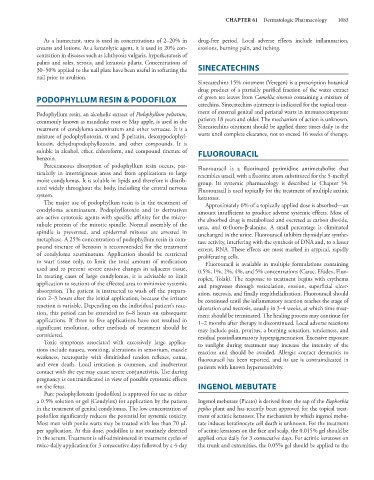Page 1097 - Basic _ Clinical Pharmacology ( PDFDrive )
P. 1097
CHAPTER 61 Dermatologic Pharmacology 1083
As a humectant, urea is used in concentrations of 2–20% in drug-free period. Local adverse effects include inflammation,
creams and lotions. As a keratolytic agent, it is used in 20% con- erosions, burning pain, and itching.
centration in diseases such as ichthyosis vulgaris, hyperkeratosis of
palms and soles, xerosis, and keratosis pilaris. Concentrations of
30–50% applied to the nail plate have been useful in softening the SINECATECHINS
nail prior to avulsion.
Sinecatechins 15% ointment (Veregen) is a prescription botanical
drug product of a partially purified fraction of the water extract
PODOPHYLLUM RESIN & PODOFILOX of green tea leaves from Camellia sinensis containing a mixture of
catechins. Sinecatechins ointment is indicated for the topical treat-
Podophyllum resin, an alcoholic extract of Podophyllum peltatum, ment of external genital and perianal warts in immunocompetent
commonly known as mandrake root or May apple, is used in the patients 18 years and older. The mechanism of action is unknown.
treatment of condyloma acuminatum and other verrucae. It is a Sinecatechins ointment should be applied three times daily to the
mixture of podophyllotoxin, α and β peltatin, desoxypodophyl- warts until complete clearance, not to exceed 16 weeks of therapy.
lotoxin, dehydropodophyllotoxin, and other compounds. It is
soluble in alcohol, ether, chloroform, and compound tincture of FLUOROURACIL
benzoin.
Percutaneous absorption of podophyllum resin occurs, par- Fluorouracil is a fluorinated pyrimidine antimetabolite that
ticularly in intertriginous areas and from applications to large resembles uracil, with a fluorine atom substituted for the 5-methyl
moist condylomas. It is soluble in lipids and therefore is distrib- group. Its systemic pharmacology is described in Chapter 54.
uted widely throughout the body, including the central nervous Fluorouracil is used topically for the treatment of multiple actinic
system. keratoses.
The major use of podophyllum resin is in the treatment of Approximately 6% of a topically applied dose is absorbed—an
condyloma acuminatum. Podophyllotoxin and its derivatives amount insufficient to produce adverse systemic effects. Most of
are active cytotoxic agents with specific affinity for the micro- the absorbed drug is metabolized and excreted as carbon dioxide,
tubule protein of the mitotic spindle. Normal assembly of the urea, and α-fluoro-β-alanine. A small percentage is eliminated
spindle is prevented, and epidermal mitoses are arrested in unchanged in the urine. Fluorouracil inhibits thymidylate synthe-
metaphase. A 25% concentration of podophyllum resin in com- tase activity, interfering with the synthesis of DNA and, to a lesser
pound tincture of benzoin is recommended for the treatment extent, RNA. These effects are most marked in atypical, rapidly
of condyloma acuminatum. Application should be restricted proliferating cells.
to wart tissue only, to limit the total amount of medication Fluorouracil is available in multiple formulations containing
used and to prevent severe erosive changes in adjacent tissue. 0.5%, 1%, 2%, 4%, and 5% concentrations (Carac, Efudex, Fluo-
In treating cases of large condylomas, it is advisable to limit roplex, Tolak). The response to treatment begins with erythema
application to sections of the affected area to minimize systemic and progresses through vesiculation, erosion, superficial ulcer-
absorption. The patient is instructed to wash off the prepara- ation, necrosis, and finally reepithelialization. Fluorouracil should
tion 2–3 hours after the initial application, because the irritant be continued until the inflammatory reaction reaches the stage of
reaction is variable. Depending on the individual patient’s reac- ulceration and necrosis, usually in 3–4 weeks, at which time treat-
tion, this period can be extended to 6–8 hours on subsequent ment should be terminated. The healing process may continue for
applications. If three to five applications have not resulted in 1–2 months after therapy is discontinued. Local adverse reactions
significant resolution, other methods of treatment should be may include pain, pruritus, a burning sensation, tenderness, and
considered. residual postinflammatory hyperpigmentation. Excessive exposure
Toxic symptoms associated with excessively large applica- to sunlight during treatment may increase the intensity of the
tions include nausea, vomiting, alterations in sensorium, muscle reaction and should be avoided. Allergic contact dermatitis to
weakness, neuropathy with diminished tendon reflexes, coma, fluorouracil has been reported, and its use is contraindicated in
and even death. Local irritation is common, and inadvertent patients with known hypersensitivity.
contact with the eye may cause severe conjunctivitis. Use during
pregnancy is contraindicated in view of possible cytotoxic effects
on the fetus. INGENOL MEBUTATE
Pure podophyllotoxin (podofilox) is approved for use as either
a 0.5% solution or gel (Condylox) for application by the patient Ingenol mebutate (Picato) is derived from the sap of the Euphorbia
in the treatment of genital condylomas. The low concentration of peplus plant and has recently been approved for the topical treat-
podofilox significantly reduces the potential for systemic toxicity. ment of actinic keratoses. The mechanism by which ingenol mebu-
Most men with penile warts may be treated with less than 70 μL tate induces keratinocyte cell death is unknown. For the treatment
per application. At this dose, podofilox is not routinely detected of actinic keratoses on the face and scalp, the 0.015% gel should be
in the serum. Treatment is self-administered in treatment cycles of applied once daily for 3 consecutive days. For actinic keratoses on
twice-daily application for 3 consecutive days followed by a 4-day the trunk and extremities, the 0.05% gel should be applied to the

